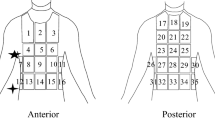Play all audios:

ABSTRACT THE increase in human sweating following acclimatization to heat is well known1. Bianca2 found that, with cattle, repeated exposure to heat (37° C) in a psychrometric laboratory
resulted in a progressive reduction in body temperature, respiratory rate and heart rate. However, there is little evidence of any causal adjustment of sweat gland activity under these
conditions. Experiments by McLean3 and Banerjee _et al._4 suggest that the sweating rates of cattle under artificial heating are directly related to the prevailing temperatures animals have
been previously exposed to. Access through your institution Buy or subscribe This is a preview of subscription content, access via your institution ACCESS OPTIONS Access through your
institution Subscribe to this journal Receive 51 print issues and online access $199.00 per year only $3.90 per issue Learn more Buy this article * Purchase on SpringerLink * Instant access
to full article PDF Buy now Prices may be subject to local taxes which are calculated during checkout ADDITIONAL ACCESS OPTIONS: * Log in * Learn about institutional subscriptions * Read our
FAQs * Contact customer support SIMILAR CONTENT BEING VIEWED BY OTHERS DYNAMIC OF UPPER BODY SWEAT DISTRIBUTION IN YOUNG MALES WEARING FULLY ENCAPSULATED CHEMICAL PROTECTIVE ENSEMBLES
Article Open access 19 January 2022 A REVIEW OF SAMPLING, ENERGY SUPPLY AND INTELLIGENT MONITORING FOR LONG-TERM SWEAT SENSORS Article Open access 03 June 2022 ELECTRODERMAL ACTIVITY AS A
PROXY FOR SWEAT RATE MONITORING DURING PHYSICAL AND MENTAL ACTIVITIES Article 01 April 2025 REFERENCES * Kuno, Y., _Human Perspiration_ (Charles C. Thomas, Springfield, Illinois, 1956).
Google Scholar * Bianca, W., _J. Agric. Sci._, 52, 296 (1959). Article Google Scholar * McLean, J. A., _J. Agric. Sci._, 61, 275 (1963). Article Google Scholar * Banerjee, M. R.,
Branton, C., Johnston, J. E., Guidry, A. J., and Breidenstein, C. P., _Proc. Southern Div. Amer. Dairy Sci. Assoc._, (February 1964). * Taneja, G. C., _J. Agric. Sci._, 52, 50 (1959).
Article Google Scholar * Murray, D. M., thesis, Univ. New England (1964). * Murray, D. M. (unpublished results). Download references AUTHOR INFORMATION AUTHORS AND AFFILIATIONS *
Department of Livestock Husbandry, University of New England, Armidale, New South Wales D. M. MURRAY Authors * D. M. MURRAY View author publications You can also search for this author
inPubMed Google Scholar RIGHTS AND PERMISSIONS Reprints and permissions ABOUT THIS ARTICLE CITE THIS ARTICLE MURRAY, D. Adaptation of Bovine Sweat Glands to a Hot Environment. _Nature_ 209,
431–432 (1966). https://doi.org/10.1038/209431a0 Download citation * Issue Date: 22 January 1966 * DOI: https://doi.org/10.1038/209431a0 SHARE THIS ARTICLE Anyone you share the following
link with will be able to read this content: Get shareable link Sorry, a shareable link is not currently available for this article. Copy to clipboard Provided by the Springer Nature
SharedIt content-sharing initiative
